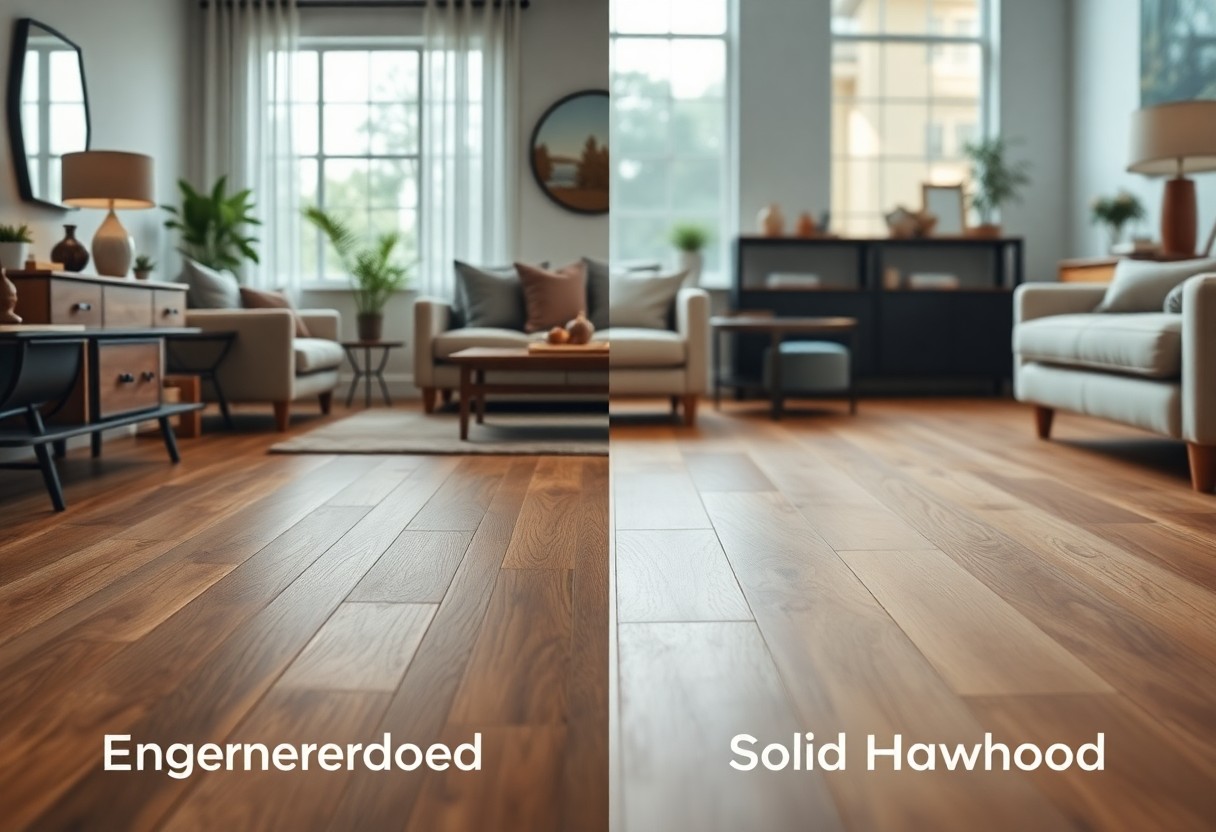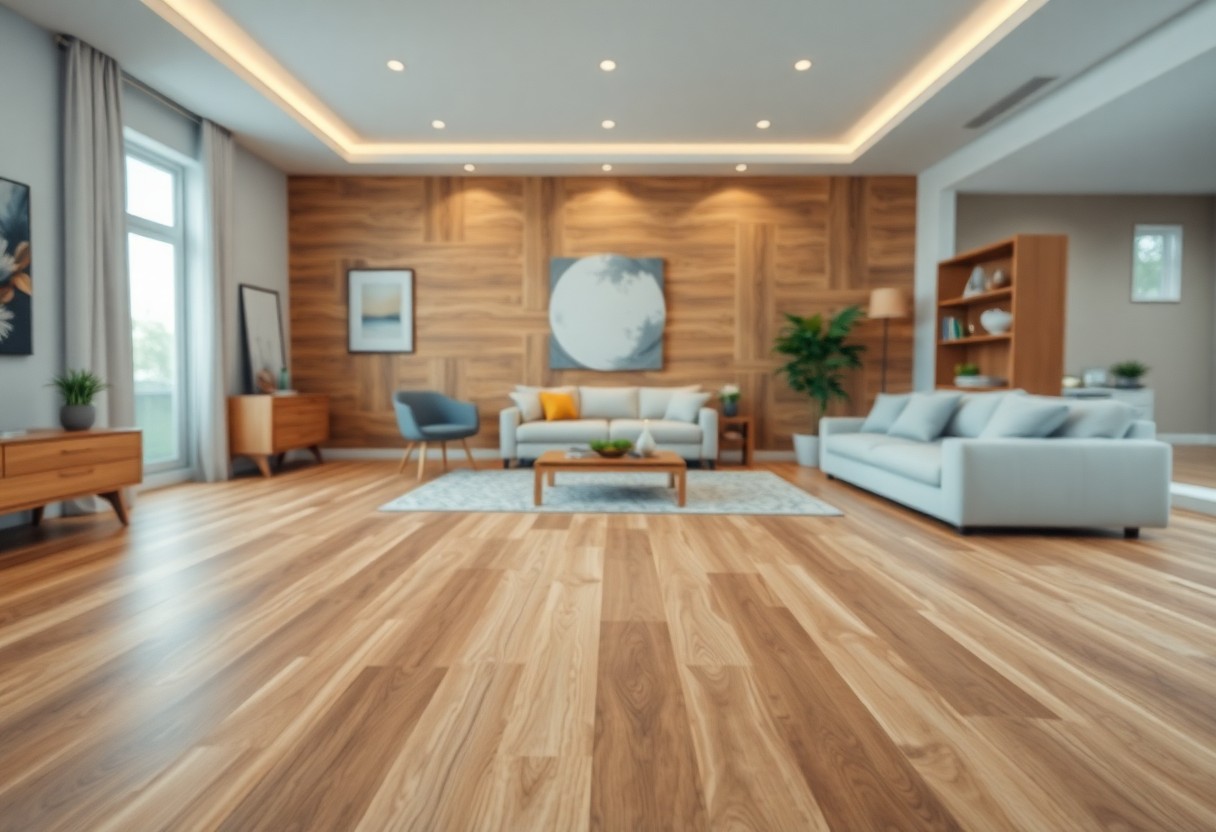Flooring choices can greatly impact the aesthetics and functionality of your home. When deciding between engineered flooring and solid hardwood, it’s imperative to understand the distinct characteristics, benefits, and drawbacks of each option. This guide will help you evaluate your specific needs, preferences, and lifestyle, ensuring you make an informed decision that complements your space and meets your long-term expectations.
Understanding Engineered Flooring
Engineered flooring offers a modern alternative to traditional hardwood, featuring a multi-layered construction that enhances stability and versatility. This type of flooring consists of a real wood veneer layer on top of several layers of plywood or high-density fiberboard, providing an appealing appearance while improving durability. It’s designed to withstand fluctuations in humidity and temperature, making it ideal for various environments, including basements and areas with underfloor heating.
Composition and Structure
Engineered flooring typically comprises three to five layers, with the topmost layer being a solid hardwood veneer, while the underlying layers are made from plywood or fiberboard. This layered configuration allows for efficient expansion and contraction without damage, making it less susceptible to warping than solid hardwood. The thickness of the veneer can vary, usually ranging from 0.6 mm to 6 mm, impacting both aesthetics and durability.
Advantages of Engineered Flooring
Engineered flooring presents multiple advantages, such as enhanced stability, cost-effectiveness, and a wide array of design options. Its ability to be installed in moisture-prone areas sets it apart from solid hardwood, making it practical for kitchens and bathrooms. Engineered flooring is also easier to maintain, with many varieties featuring scratch-resistant finishes that help preserve its beauty over time.
Beyond its stability and versatility, engineered flooring can be more environmentally friendly. Many manufacturers source their materials from sustainable forests, ensuring minimal impact on the environment. Additionally, the production process often involves less waste than that of solid hardwood, making it an attractive choice for eco-conscious consumers. With a vast selection of styles, colors, and finishes available, you can effortlessly match your engineered flooring to your existing décor, ensuring that your space looks polished and inviting.
Exploring Solid Hardwood
Solid hardwood flooring remains a timeless choice for many homeowners, renowned for its natural beauty and durability. Unlike engineered options, solid hardwood is milled from a single piece of wood, providing a warm aesthetic that enhances any interior. Available in a variety of species and finishes, solid hardwood can elevate your space while offering a classic feel that engineered flooring often lacks.
Characteristics and Composition
Solid hardwood consists of 100% natural wood, typically cut directly from specific tree species like oak, maple, or cherry. This uniformity in composition results in distinctive grain patterns and coloration, accentuating the organic beauty of the material. The thickness of solid hardwood planks usually ranges from 3/4 inch to 1 inch, providing stability and a substantial feel underfoot.
Benefits of Solid Hardwood
Solid hardwood delivers several advantages, including unmatched durability and longevity. With proper care, these floors can last for generations, making them a worthwhile investment. You can sand and refinish solid hardwood multiple times, allowing you to rejuvenate the surface and adapt to changing style preferences. Additionally, solid wood has excellent thermal and acoustic properties, contributing to a cozy indoor atmosphere.
The exceptional durability of solid hardwood not only ensures longevity but also enhances resale value. Homes featuring solid hardwood flooring often attract premium pricing, as many buyers appreciate the elegance and high-quality craftsmanship. Additionally, solid hardwood is a sustainable option, particularly if sourced from responsibly managed forests. Therefore, it stands as both an aesthetic choice and a smart investment for your property.
Comparing Durability and Longevity
When choosing between engineered flooring and solid hardwood, durability and longevity are crucial factors. Engineered flooring tends to outperform solid hardwood in environments with fluctuating humidity and temperature, thanks to its layered structure designed to resist warping. Solid hardwood, while sturdy, may require more care in moisture-prone areas. Below is a comparison of the two.
| Attribute | Engineered Flooring | Solid Hardwood |
|---|---|---|
| Durability | Highly durable, resistant to wear | Durable but can scratch or dent easily |
| Longevity | Lasts 20+ years with proper care | Can last 50+ years if maintained well |
Resistance to Moisture and Temperature Changes
You’ll find that engineered flooring excels in areas with high moisture and temperature variability. Its multi-layered construction helps mitigate the risk of warping and buckling, making it a smart choice for basements and kitchens. Solid hardwood, on the other hand, can be susceptible to these changes, potentially leading to costly damage over time.
| Material | Moisture Resistance |
|---|---|
| Engineered Flooring | Highly resistant to moisture |
| Solid Hardwood | Less resistant, prone to damage |
Lifespan and Wear Resistance
The lifespan of your flooring will significantly depend on the material’s resistance to wear. Engineered flooring typically features a veneer of hardwood that can be refinished, although it can only be sanded down a couple of times. Solid hardwood can withstand years of wear and tear, allowing for multiple refinishes throughout its life. On average, engineered flooring lasts about 20 to 30 years, while solid hardwood ranges from 50 to 100 years with proper maintenance, making it a long-term investment for homeowners.

Aesthetic Appeal and Design Options
The aesthetic appeal of your flooring significantly impacts your home’s overall ambiance. Engineered flooring mimics the look of solid hardwood but offers more design options, allowing you to choose from various styles that complement your decor. Solid hardwood, with its unique grain patterns and rich hues, offers a timeless elegance that can enhance the charm of traditional and modern homes alike.
Variety of Styles and Finishes
You’ll find that engineered flooring comes in a multitude of styles and finishes, making it easier to achieve the look you desire. Options range from rustic oak to sleek maple, with finishes that can enhance or downplay the natural wood grain. This flexibility allows you to match your flooring seamlessly with your existing furniture and color schemes.
Impact on Home Value
The choice between engineered flooring and solid hardwood can influence your home’s value. While solid hardwood typically appeals to buyers seeking longevity and classic aesthetics, quality engineered flooring can also enhance appeal, especially in areas prone to moisture. Knowing the expected return on investment for both options will help you make a more informed decision.
Solid hardwood floors tend to have a higher perceived value and can yield a return on investment of about 70-80% when selling your home. Engineered flooring, on the other hand, can still positively impact appraisal values, particularly in markets where modern design trends prevail. If you choose high-quality engineered options that mimic the look of traditional wood, you can maintain a competitive edge in your market, ensuring your investment remains sound.
Installation and Maintenance
The choice between engineered flooring and solid hardwood can significantly impact installation and upkeep. Engineered flooring often features a click-lock system, allowing for easier DIY installation without glue or nails, while solid hardwood typically requires professional installation due to its complexities. Maintenance may vary, with solid wood requiring more vigilance against humidity changes, whereas engineered can withstand moisture better, reducing concerns in areas like basements.
Installation Methods and Costs
Engineered flooring’s installation usually comes with lower costs and fewer labor requirements due to its floating installation method, which doesn’t need nails or glue. Solid hardwood installation can be pricier and time-consuming, often entailing nail-down or glue-down techniques. Costs can vary widely from $3 to $12 per square foot for engineered flooring and $6 to $15 for solid hardwood, depending on the material quality and labor involved.
Care and Maintenance Tips
To keep your flooring in top condition, routine cleaning and mindful care are crucial. For both engineered and solid hardwood, maintain a regular cleaning schedule using a soft broom or vacuum to prevent scratches. Use a damp mop with a suitable cleaner to maintain shine, and apply protective pads beneath furniture to minimize wear. The humidity level should be consistently managed to avoid warping, especially for solid wood. Thou.
- Regularly sweep or vacuum to eliminate dust and dirt.
- Use a damp mop with a wood floor cleaner for deeper cleaning.
- Keep humidity levels between 30%-50% to prevent warping.
- Apply protective pads under furniture to reduce scratches.
- Thou.
Investing in regular maintenance can lengthen the life of your flooring. Avoid harsh chemicals and choose products specifically designed for wood floors. If spills occur, clean them immediately to prevent stains, and consider refinishing solid hardwood every 5-10 years for sustained quality. Thou.
- Choose cleaners formulated specifically for your floor type.
- Address spills promptly to prevent permanent stains.
- Consider refinishing solid hardwood floors every 5-10 years.
- Thou.
Cost Considerations
When weighing engineered flooring against solid hardwood, understanding the cost implications is crucial. Initially, engineered flooring tends to be more budget-friendly, often ranging from $3 to $10 per square foot, while solid hardwood can set you back anywhere from $5 to $15 or more. However, factors such as longevity, maintenance costs, and potential resale value should be considered, as they can influence your overall investment.
Initial Investment vs. Long-term Value
Your initial investment in flooring should be balanced with long-term value. Engineered flooring may save you money upfront, but solid hardwood often appreciates, enhancing your home’s value. Over time, the durability of solid hardwood can result in a higher return if you plan to sell, making it a wise choice for homeowners focused on resale.
Budget-friendly Options
For those on a tight budget, engineered flooring delivers quality without the hefty price tag associated with solid hardwood. You can find attractive options that offer the look of natural wood at lower costs. Additionally, many manufacturers provide affordable lines of engineered planks that mimic the aesthetic of high-end woods, allowing for design versatility without breaking the bank.
The budget-friendly engineered flooring options can include varieties like oak, maple, or walnut finishes, all while maintaining a lower price point compared to solid hardwood. For example, a high-quality engineered plank may cost around $5 per square foot, providing a significant savings versus solid hardwood that could exceed $10 per square foot. This makes it an appealing choice for DIY projects, renovations, or areas with high foot traffic where cost-effective durability is desired.
To wrap up
From above, it’s clear that choosing between engineered flooring and solid hardwood hinges on your specific needs and preferences. If you seek durability and moisture resistance, engineered flooring may be your best option. However, if you prioritize authenticity, long-lasting beauty, and the ability to refinish, solid hardwood could be ideal. Assess factors such as climate, installation space, and budget to determine which flooring type aligns most closely with your lifestyle and aesthetic goals.





